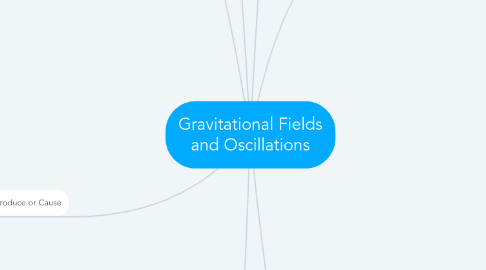
1. Types of Oscillations
1.1. Free Oscillations
1.1.1. Its Definition Is
1.1.1.1. When an object oscillates in its own natural frequency and under no external influence
1.2. Forced Oscillations
1.2.1. Its Definition Is
1.2.1.1. When an object oscillates due to being driven by an external, periodic force
2. Oscillations Can Produce or Cause
2.1. Simple Harmonic Motion
2.1.1. Its Definition Is
2.1.1.1. When an object's acceleration is directly proportional to its displacement from its equilibrium position, and in opposite to its displacement
2.1.2. Its Requirements Are
2.1.2.1. A mass the oscillates
2.1.2.2. The mass must have an equilibrium position
2.1.2.3. The restoring force must act on the mass to return the mass to its equilibrium position
2.1.3. Velocity Is Constantly Changing Because
2.1.3.1. The direction of the velocity constantly changes, and a change in velocity means that the object is accelerating
2.1.4. The Equations Are
2.1.4.1. X= xsin(ωt) | X= xcos(ωt)
2.1.4.2. a=-ω^2x
2.1.4.3. v=ωx
2.1.4.4. v= +- ω(X^2 - x^2) ^(1/2)
2.2. Damping
2.2.1. Its Definition Is
2.2.1.1. When the amplitude of the oscillations are constantly decreased
2.2.2. Its Use Is To
2.2.2.1. Reduce Vibrations
2.2.3. The Types Are
2.2.3.1. Light Damping
2.2.3.2. Heavy Damping
2.3. Resonance
2.3.1. Its Definition Is
2.3.1.1. When the forced motion of an oscillator characterized by the maximum amplitude when the forcing frequency matches the oscillating frequency
3. Oscillations Can be Represented by
3.1. Graphing
3.1.1. Velocity - Time
3.1.2. Acceleration - Time
4. Oscillations Can be Described By
4.1. Amplitude
4.2. Period
4.3. Frequency
4.4. Phase
4.5. Sinusodial Motion
5. Gravitational Fields Have
5.1. Gravitational Field Strength
5.1.1. Are Represented by Lines
5.1.1.1. Shows the Direction
5.1.1.2. Spacing Indicates Strength
5.1.2. Its Definition Is
5.1.2.1. The gravitational force exerted per unit mass on a small object placed at the point
5.1.3. The Formulas Are
5.1.3.1. F=(GMm)/r^2
5.1.3.2. g=F/m
5.1.3.2.1. g=GM/r^2
6. Energy in a Gravitational Field Produces
6.1. Gravitational Potential Energy
6.1.1. Its Formula Is
6.1.1.1. GPE=mgh
6.1.2. Its Basic Concept Is
6.1.2.1. The higher an object is lifted, the more work is done into it, so gravitational potential energy is increased
6.1.2.2. However this isn't applicable in space, where g is zero, and that g decreases the greater the height
6.2. Gravitational Potential
6.2.1. Its Definition Is
6.2.1.1. Work done per unit mass in bringing a mass from infinity to a certain point
6.2.1.2. Potential energy of a unit mass at a point
6.2.2. Its Formula Is
6.2.2.1. ϕ=-GM/r
7. Gravitational Fields Cause
7.1. Orbiting
7.1.1. Gravitational Forces Provides
7.1.1.1. Centripetal Force
7.1.2. Circular Paths
7.1.2.1. Objects Orbiting a Mass are Called Satellites
7.1.2.2. The gravitational force is at right angles to the velocity of the satellite
7.1.2.3. Geostationary Orbit
7.1.2.3.1. Circular Orbit
7.1.2.3.2. Elliptical Orbit
7.1.3. The Formulas Are
7.1.3.1. F=mv^2/r
7.1.3.2. GMm/r^2 = mv^2/r
7.1.3.2.1. v^2=GM/r
7.1.4. Period
7.1.4.1. The time taken for a satellite to complete an orbit
7.1.4.2. The Formulas Are
7.1.4.2.1. v=2πr/T
7.1.4.2.2. (4π^2r^2)/T^2 = GM/r
